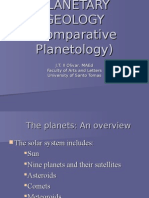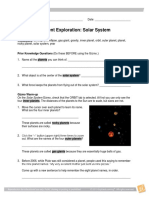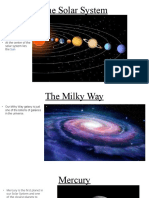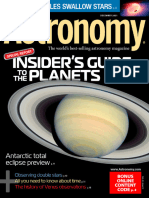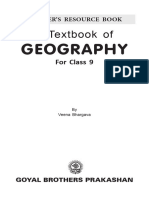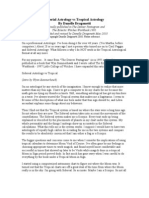Astronomy Topic 1
Astronomy Topic 1
Uploaded by
Dinesh JisangkarCopyright:
Available Formats
Astronomy Topic 1
Astronomy Topic 1
Uploaded by
Dinesh JisangkarOriginal Description:
Original Title
Copyright
Available Formats
Share this document
Did you find this document useful?
Is this content inappropriate?
Copyright:
Available Formats
Astronomy Topic 1
Astronomy Topic 1
Uploaded by
Dinesh JisangkarCopyright:
Available Formats
DCG2063 – FIELD ASTRONOMY 1.
3 GREAT CIRCLE SPHERICAL ELEMENTS
TOPIC 1 1.3.1 SOLAR SYSTEM
Our solar system consists of a sun and 9 planets. The
At the end of this topic, students will be able to: planets move in anti-clockwise direction around the
1.1 Describe field astronomy and its uses sun in an elliptical orbit. Those planets are Mercury
1.2 Describe celestial sphere for an observer on the earth (Utarid), Venus (Zuhrah), Earth, Mars (Marikh),
1.3 Explain elements of celestial sphere Jupiter (Musytari), Saturn (Zuhal), Uranus, Neptune
1.4 Describe sun, earth, planet, and moon movements in the solar (Waruna) and Pluto. There are also natural satellites
system orbiting the planets, e.g. moon orbiting the earth.
1.5 Describe seasonal changes
Besides, there are also stars, comet and asteroids
1.1 DEFINITION around our solar system.
Field astronomy can be describe as the study of the relative
position of the celestial bodies such as sun, stars, moon and 1.3.2 CELESTIAL SPHERE
planets with respect to the earth. A celestial sphere is an imaginary sphere formed by
the stars in the sky, where earth is located at the
1.2 FUNCTION OF FIELD ASTRONOMY centre.
Astronomy is important to surveyor and geodesy specialist to
carry out survey works such as cadastral survey, topographic
survey, geodetic survey, hydrographic survey and other
related survey that leads to mapping. There are TWO (2)
main functions of field astronomy.
1.2.1 LAND SURVEY
i. To determine azimuth of a boundary line through
astronomical observation 1.3.3 ELEMENTS OF CELESTIAL SPHERE
ii. To uniform the survey works and system between Horizon Circle (H) – is a great circle formed by the
separated land blocks intersection of the celestial sphere plane and the
iii. As a verification of angle for a long traverse line horizontal plane
where sun observation is performed at every 25 Zenith (Z) & Nadir (Na) – are two points located at
stations the end of a vertical line perpendicular to the horizon.
iv. To determine geodetic position i.e. latitude (ø) & Zenith is located directly overhead the observer while
longitude (λ) on earth through astronomical Nadir is located directly below the observer.
observation
1.2.2 ISLAMIC ASTRONOMY
i. To determine prayer times
ii. To determine kiblah direction
iii. To determine important dates in Islamic calendar
such as Awal Ramadhan, Aidilfitri, Aidiladha etc.
Celestial Pole (CP) - is the intersection between the
celestial sphere and the earth polar axis. In the
northern hemisphere, it is called North Celestial Pole
(NCP) and in the southern hemisphere, it is called
South Celestial Pole (SCP).
Celestial Equator (CE) – is a great circle perpendicular Figure 1.1: The elements of celestial sphere
to the celestial pole axis and parallel with the earth
equator axis and intersects with celestial sphere. 1.4 MOTIONS OF THE CELESTIAL BODIES IN THE SOLAR
Observer’s Celestial Meridian (CM) – is a great circle SYSTEM
that passes through North Point on the horizon, NCP,
Zenith and South Point. The intersection between the 1.4.1 APPARENT STAR MOTION
CM and horizon circle at the same part with NCP The earth rotates on its axis from west to east. If we
determines the North Point while the intersection of assumed that the earth is not rotating, we may see
the CM and horizon circle at the same part with SCP the stars rise at the east and set at the west. We can
determines the South Point. conclude that the apparent motion of the stars and
Prime Vertical (PV) – is a great circle perpendicular to other celestial bodies as moving on the celestial
the horizon circle and meridian circle that passes both sphere from east to west around the polar axis once
Zenith and Nadir. The intersection between PV and CE in 24hr sidereal time.
at the eastern part determines the East point while
the intersection between PV and CE at the western Star motion in northern hemisphere
part determines the West point. On the earth, PV is Star rise in the east and sets at the west. For stars
known as Prime Meridian. that rise above celestial equator, it has north
declination (δN). For stars that rise below celestial
equator, it has south declination (δS).
Group of stars
There are SEVEN (7) groups of stars.
Group 1: are the north polar star which moves closest
to the north pole, has small polar distance, can be
seen from high latitudes but cannot be seen from The altitude of the stars from the horizon also does
places near the equator and southern hemisphere. not change.
Group 2: are the north circumpolar star where its
polar distance is less than the latitude of the observer
and can be seen the whole day from any places on
the northern hemisphere because it isn’t rise or sets.
Group 3: are the stars located farthest from the North
Pole, rise at the east and set at the west, duration
above the horizon is longer than below horizon.
Group 4: are the equatorial stars that moves along
the celestial equator and has declination nearly 0°,
may have equal duration above and below horizon
(12hrs).
Group 5, 6 & 7: are the southern stars that have
opposite properties from the northern stars.
Figure 1.3: The view of the observer located at the north pole.
Stars as seen from the equator
The observer at the equator can see all groups of
stars. All stars are seen to be rise in the east and set 1.4.2 EARTH MOTION
at the west. The duration above and below the In our solar system, the earth has TWO (2)
horizon may be equal. movements:
Diurnal/Daily motion
The earth rotates on its axis (360°) once in 24hrs
solar time or 23hrs 56mins sidereal time from west to
east. This rotation results in stars moves from east to
west and the changes of day and night.
Annual motion
The earth moves around the sun once a year
(365.2422 days) in anti-clockwise direction on an
elliptical orbit where the sun is the focus point.
1.4.3 ANNUAL APPARENT SUN MOTION
The annual apparent sun motion is a reversed motion
where the diurnal motion is seen to be rise at the east
Figure 1.2: The view of the observer located at the equator and set at the west according to the earth rotation on
its axis. The non-uniform movement of the sun
Stars as seen from the north pole between its annual (moves along ecliptic) and diurnal
All stars is seen to be moves parallel to the horizon motion (moves along equator) results in spiral
circle. It has not rise or set, so that the observer may motions on the celestial sphere.
see all the northern stars except the southern stars.
Autumn Equinox
The sun directly on the equator with 0° declination on 22nd
or 23rd September. At this time the northern hemisphere is
in autumn equinox. The length of the day and night is equal
at all places (12 hrs). At this time, the sun is crossing the
equator from north to south.
Winter Solstice
The sun directly on the Tropic of Capricorn with a maximum
of 23.5° of south declination on 21st or 22nd December. At
this time, it is winter solstice in the northern hemisphere.
The length of the day for the northern hemisphere is the
shortest in the year where the closest a place to the north
pole, the shortest the daylight it receives. At the Artic circle,
it is 24hrs darkness while at the Antarctic circle, it is 24hrs
daylight.
Figure 1.4: The sun motion
1.5 SEASONAL CHANGES
The changes of the seasons on earth is because of the earth
movement around the sun and the tilting of the earth axis to
the ecliptic plane (66° 33.5’)
Spring Equinox
The sun directly on the equator with 0° declination on 21st or
22nd March. At this time the northern hemisphere is in spring
equinox. The length of the day and night is equal at all
places (12 hrs). At this time, the sun is crossing the equator
from south to north.
Summer Solstice
The sun directly on the Tropic of Cancer with a maximum of
23.5° of north declination on 21st or 22nd June. At this time, ~ END OF TOPIC 1 ~
it is summer solstice in the northern hemisphere. The length
of the day for the northern hemisphere is the longest in the
year where the closest a place to the north pole, the longer
the day time it receives. At the Artic circle, it is 24hrs
daylight while at the Antarctic circle, it is 24hrs of darkness.
You might also like
- Space L5 Orbits PowerPointDocument15 pagesSpace L5 Orbits PowerPointkenNo ratings yet
- Results Sheet 7 The SeasonsDocument4 pagesResults Sheet 7 The SeasonsGamtessa AddisuNo ratings yet
- StarAlt Guide (Astronomy)Document4 pagesStarAlt Guide (Astronomy)JuanNo ratings yet
- Stellarium - Star MapDocument8 pagesStellarium - Star Mapmjosemorales0% (1)
- Cluster Ages Lab Exercise MCDocument10 pagesCluster Ages Lab Exercise MCdan25% (4)
- H9-Modeling Expanding UniverseDocument20 pagesH9-Modeling Expanding UniverseArnie Jay AnasariasNo ratings yet
- Chapter 24 - The Solar SystemDocument36 pagesChapter 24 - The Solar SystemHeather Blackwell100% (1)
- Vivaha+Patala+ of+Sage+Saunaka+and+Mihira +-+sampleDocument13 pagesVivaha+Patala+ of+Sage+Saunaka+and+Mihira +-+sampleANANTHPADMANABHAN100% (2)
- The Story of Science. A History of Science, Technology and Medicine From 5000 BC To The End of The 20th Century PDFDocument1,290 pagesThe Story of Science. A History of Science, Technology and Medicine From 5000 BC To The End of The 20th Century PDFMohammed ElnaggarNo ratings yet
- Moon Phases TidesDocument21 pagesMoon Phases TideszeeschoolNo ratings yet
- The Life Cycle of StarsDocument11 pagesThe Life Cycle of StarsJake Bennett-WoolfNo ratings yet
- 03+ +Origins+of+Modern+AstronomyDocument33 pages03+ +Origins+of+Modern+AstronomyReyes LykaNo ratings yet
- LifecyleofstarsDocument32 pagesLifecyleofstarsWayne David C. PadullonNo ratings yet
- Solar System - Wikipedia, The Free EncyclopediaDocument24 pagesSolar System - Wikipedia, The Free EncyclopediaAriana BalidoyNo ratings yet
- Guide To Astronomy and The UniverseDocument205 pagesGuide To Astronomy and The UniverseyonderuyoNo ratings yet
- Stellar EvolutionDocument5 pagesStellar EvolutionMayar AzzamNo ratings yet
- ws1 2008Document12 pagesws1 2008gebikimameNo ratings yet
- Planetary GeologyDocument30 pagesPlanetary Geologyapi-3744104No ratings yet
- Beyond The Solar SystemDocument10 pagesBeyond The Solar SystemDyuvan D MachaarandaNo ratings yet
- Compare The Size of The Earth With Other PlanetsDocument16 pagesCompare The Size of The Earth With Other PlanetsArif ShiekhNo ratings yet
- Remnants of Rock and Ice: Asteroids, Comets, and PlutoDocument79 pagesRemnants of Rock and Ice: Asteroids, Comets, and PlutoAlain Sayson PresillasNo ratings yet
- Geography - Universe & Solar System Old - English - 1608316685Document22 pagesGeography - Universe & Solar System Old - English - 1608316685ribasefNo ratings yet
- Students Module e Unit 1 Lesson 1 Exploration 3 Relating Air Circulation To The Earth SystemDocument13 pagesStudents Module e Unit 1 Lesson 1 Exploration 3 Relating Air Circulation To The Earth Systemapi-240724606100% (1)
- Solarsystem Worksheet For Gizmo AssignmentDocument3 pagesSolarsystem Worksheet For Gizmo Assignmentapi-49005894467% (3)
- What Are Longitudes and LatitudesDocument2 pagesWhat Are Longitudes and LatitudesClaudene GellaNo ratings yet
- The HR DiagramDocument5 pagesThe HR DiagramZhiyong HuangNo ratings yet
- Astronomy, Vol. 49.2 (February 2021)Document68 pagesAstronomy, Vol. 49.2 (February 2021)georgetacaprarescuNo ratings yet
- Simple Cosmological Models: Detail AnalysisDocument28 pagesSimple Cosmological Models: Detail AnalysisShearyar KhanNo ratings yet
- Origin of Modern AstronomyDocument41 pagesOrigin of Modern AstronomyNordianaNo ratings yet
- Astronomy, Vol. 51.12 (December 2023)Document64 pagesAstronomy, Vol. 51.12 (December 2023)georgetacaprarescu100% (1)
- Local Media3433401578249032055Document16 pagesLocal Media3433401578249032055henielle camposNo ratings yet
- GEO 204 - Stars and ConstellationsDocument20 pagesGEO 204 - Stars and ConstellationsMarilyn Buac OgocNo ratings yet
- SPACE Notes 4 and 5Document16 pagesSPACE Notes 4 and 5Shashwat TripathiNo ratings yet
- Module 1 Space EnvironmentDocument9 pagesModule 1 Space EnvironmentPrajwal B NaikNo ratings yet
- SCI 202-Stars and GalaxiesDocument4 pagesSCI 202-Stars and Galaxiesnetflix accountNo ratings yet
- Topic 4 - Bigger and Smarter TelescopesDocument5 pagesTopic 4 - Bigger and Smarter Telescopesapi-208538578No ratings yet
- Practice Test SpaceDocument8 pagesPractice Test Spaceapi-291011460100% (1)
- Earth and Space QuizDocument2 pagesEarth and Space QuizsangiprabakarNo ratings yet
- 2009 Physics NotesDocument12 pages2009 Physics NotesTon5698No ratings yet
- The Solar SystemDocument14 pagesThe Solar SystemNonj MkhizeNo ratings yet
- Lecture 1 - Introduction To Astronomy (White Background)Document16 pagesLecture 1 - Introduction To Astronomy (White Background)bizzydude100% (1)
- Exploring The Night Sky Lab 2Document2 pagesExploring The Night Sky Lab 2humza sattiNo ratings yet
- Astronomy, Vol. 49.12 (December 2021)Document76 pagesAstronomy, Vol. 49.12 (December 2021)georgetacaprarescuNo ratings yet
- Jupiter and SaturnDocument27 pagesJupiter and Saturnbryan tolabNo ratings yet
- The Outer PlanetsDocument8 pagesThe Outer PlanetsKyle TadifaNo ratings yet
- 9702Document33 pages9702pedodanNo ratings yet
- CH 28Document33 pagesCH 28Chrizziel Jean KayeNo ratings yet
- The Milky Way Galaxy: Astronomy 110: SURVEY OF ASTRONOMYDocument75 pagesThe Milky Way Galaxy: Astronomy 110: SURVEY OF ASTRONOMYColumbia GomezNo ratings yet
- Astronomy Powerpoint CHP 1Document18 pagesAstronomy Powerpoint CHP 1emailtotesttestNo ratings yet
- Electromagnetic Induction Practice Problems-2009!05!13Document15 pagesElectromagnetic Induction Practice Problems-2009!05!13anon020202No ratings yet
- Europa - OrbiterWikiDocument7 pagesEuropa - OrbiterWikiKim NguyenNo ratings yet
- Lifting Titan's Veil: Exploring The Giant Moon of SaturnDocument22 pagesLifting Titan's Veil: Exploring The Giant Moon of SaturnFer MontesinosNo ratings yet
- Astronomy Constellations and Their TypesDocument5 pagesAstronomy Constellations and Their TypesMama MoNo ratings yet
- Astronomy Unit 1 3 - Earth-Sun RelationshipDocument34 pagesAstronomy Unit 1 3 - Earth-Sun Relationshipapi-278569039No ratings yet
- Stars and Galaxies in The UniverseDocument29 pagesStars and Galaxies in The UniverseINSYIRAH BINTI M ZAIRURLAIL 105No ratings yet
- St. Joseph Astronomy Olympiad 2015 (Junior)Document3 pagesSt. Joseph Astronomy Olympiad 2015 (Junior)Science Olympiad Blog100% (1)
- PLANETA SATURNO TripticoDocument6 pagesPLANETA SATURNO TripticoRosario Crisostomo GuerraNo ratings yet
- The Sun & Stars: Morgan George, Samantha GiddingeDocument18 pagesThe Sun & Stars: Morgan George, Samantha GiddingemorganNo ratings yet
- The Planets Print (OU - BBC) 2019Document2 pagesThe Planets Print (OU - BBC) 2019kevin clearyNo ratings yet
- Earth & UniverseDocument19 pagesEarth & UniverseCalvinRodgers100% (1)
- Famous Scientists and What They Did : Pre-K Science Series: Scientists for Kids Preschool BooksFrom EverandFamous Scientists and What They Did : Pre-K Science Series: Scientists for Kids Preschool BooksNo ratings yet
- 50 Years of Solar System Exploration: Historical Perspectives (With Original NASA Photographs)From Everand50 Years of Solar System Exploration: Historical Perspectives (With Original NASA Photographs)No ratings yet
- Class 3-Dps-evs-The Sun N The Earth-2019Document2 pagesClass 3-Dps-evs-The Sun N The Earth-2019ArchanaGupta0% (1)
- General Nav Class TestDocument11 pagesGeneral Nav Class TestPraveen ChoudharyNo ratings yet
- A Short Guide To Celestial Navigation - UmlandDocument98 pagesA Short Guide To Celestial Navigation - UmlandEnrico PieroniNo ratings yet
- Calendar 101 - What in The World Is A Covenant Calendar (5 PGS) June 2020Document5 pagesCalendar 101 - What in The World Is A Covenant Calendar (5 PGS) June 2020AnonymousNo ratings yet
- Global Climate ChangeDocument315 pagesGlobal Climate ChangeAkansha RaiNo ratings yet
- Mathematics of Astrology PDFDocument37 pagesMathematics of Astrology PDFpkapur84100% (1)
- Wiley Bulletin of The Institute of Classical Studies. SupplementDocument25 pagesWiley Bulletin of The Institute of Classical Studies. SupplementJan MarcovitchNo ratings yet
- Learnenglish Teens Read Uk Earth HourDocument5 pagesLearnenglish Teens Read Uk Earth HourBelinda AngelesNo ratings yet
- Time TurningPointsDocument11 pagesTime TurningPointsMohamed Wahid100% (4)
- Calendar and Exodus 34v22 (Ucg)Document10 pagesCalendar and Exodus 34v22 (Ucg)Tim KitchenNo ratings yet
- Greek RomanCalendars ConstructionsOfTime PDFDocument176 pagesGreek RomanCalendars ConstructionsOfTime PDFSrimathi Amala Pushpika100% (4)
- Orbital Aspects of Satellite CommunicationsDocument20 pagesOrbital Aspects of Satellite CommunicationsLee Robine100% (1)
- 2 - Questions - Homework - 6th - Social Studies - 2023-06-16T06 - 13Document4 pages2 - Questions - Homework - 6th - Social Studies - 2023-06-16T06 - 13acguptaclassesNo ratings yet
- Natural Trigonometric Functions: CSC, Sec & Co-TanDocument7 pagesNatural Trigonometric Functions: CSC, Sec & Co-TanGeorge CarinoNo ratings yet
- Guangjun Zhang Star Identification Methods, Techniques and AlgorithmsDocument231 pagesGuangjun Zhang Star Identification Methods, Techniques and Algorithmsphungphuongnam68No ratings yet
- Pre Samiksha Test 11 Geography Environment and Mapping SolutionDocument78 pagesPre Samiksha Test 11 Geography Environment and Mapping SolutionDivya TripNo ratings yet
- TRB Geography 9Document135 pagesTRB Geography 9ayushyadav5775100% (1)
- Longnitude LatitudeDocument6 pagesLongnitude Latitudemohanr786No ratings yet
- Space PhysicsDocument38 pagesSpace PhysicsAminah Shahzad100% (1)
- Earth SeasonsDocument2 pagesEarth SeasonsAnup GuptaNo ratings yet
- Astronomy Coursework Shadow StickDocument6 pagesAstronomy Coursework Shadow Stickf1vijokeheg3100% (2)
- AstrologyDocument63 pagesAstrologyFrancis LoboNo ratings yet
- Siderial Astrology vs. Tropical AstrologyDocument5 pagesSiderial Astrology vs. Tropical AstrologyDanelle Dragonetti100% (2)
- Part 1 Astronomical CyclesDocument37 pagesPart 1 Astronomical Cyclesashutosh1966No ratings yet
- Tropical Design Reviewer (With Answers)Document2 pagesTropical Design Reviewer (With Answers)Jan Nikolai GongoraNo ratings yet
- Disha 1000 MCQ 3Document100 pagesDisha 1000 MCQ 3Jai HoNo ratings yet
- Digital Hampi Preserving Indian Cultural Heritage Anupama Mallik 2024 Scribd DownloadDocument54 pagesDigital Hampi Preserving Indian Cultural Heritage Anupama Mallik 2024 Scribd Downloadmirriyeates100% (4)


















